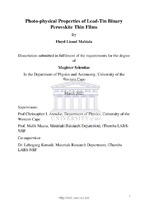| dc.contributor.advisor | Arendse, Christopher J. | |
| dc.contributor.advisor | Maaza, Malik | |
| dc.contributor.author | Mabiala, Floyd Lionel | |
| dc.date.accessioned | 2021-03-19T07:39:28Z | |
| dc.date.available | 2021-03-19T07:39:28Z | |
| dc.date.issued | 2021 | |
| dc.identifier.uri | http://hdl.handle.net/11394/8002 | |
| dc.description | >Magister Scientiae - MSc | en_US |
| dc.description.abstract | Organic-inorganic lead-based perovskite has exhibited great performance in the past few years.
However, the lead (Pb) embedded in those compounds is a significant drawback to further
progress, due to its environmental toxicity. As an alternative, tin (Sn) based-perovskites have
demonstrated promising results in terms of electrical and optical properties for photovoltaic
devices, but the oxidation of tin ion- from stannous ion (Sn2+) to stannic ion (Sn4+) presents a
problem in terms of performance and stability when exposed to ambient conditions. A more
feasible approach may be in a Pb-Sn binary metal perovskite in pursuit of efficient, stable
perovskite solar cells (PSCs) with reduced Pb-content, as compared to pure Pb- or Sn-based
PSCs. Here, we report on the deposition of a Pb-Sn binary perovskite by sequential chemical
vapor deposition. | en_US |
| dc.language.iso | en | en_US |
| dc.publisher | University of Western Cape | en_US |
| dc.subject | Organic-inorganic perovskite | en_US |
| dc.subject | Binary metal alloy | en_US |
| dc.subject | Chemical vapour deposition (CVD) | en_US |
| dc.subject | X-ray diffraction (XRD) | en_US |
| dc.subject | UV-VIS spectroscopy | en_US |
| dc.title | Photo-physical properties of lead-tin binary Perovskite thin films | en_US |
| dc.rights.holder | University of Western Cape | en_US |

